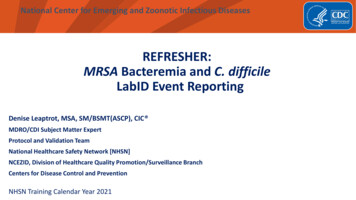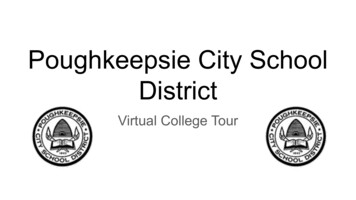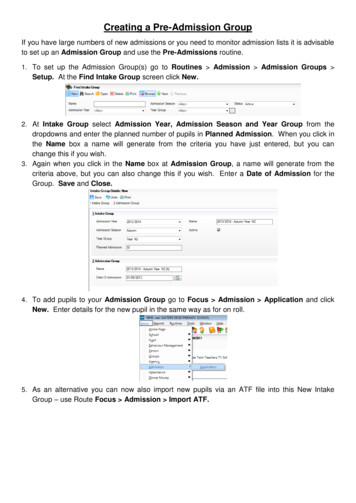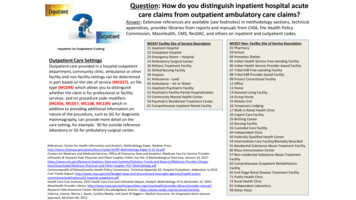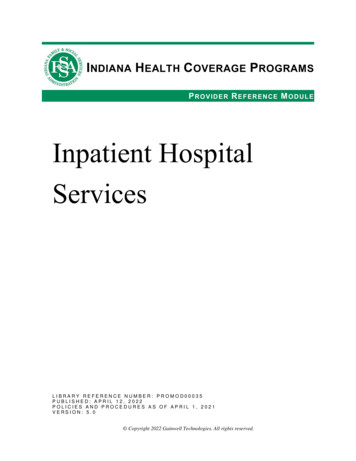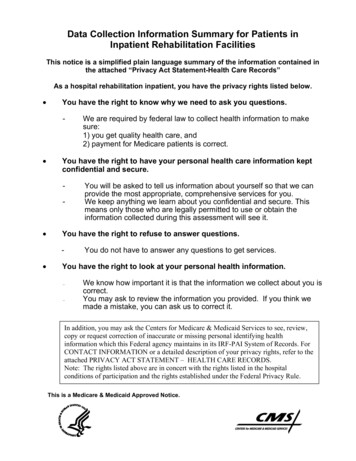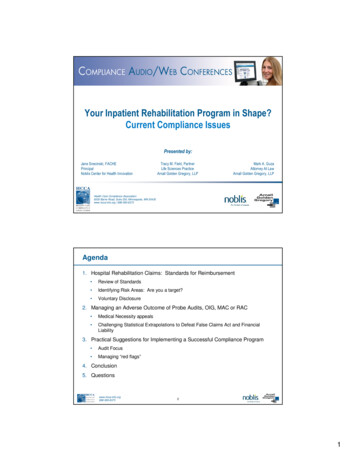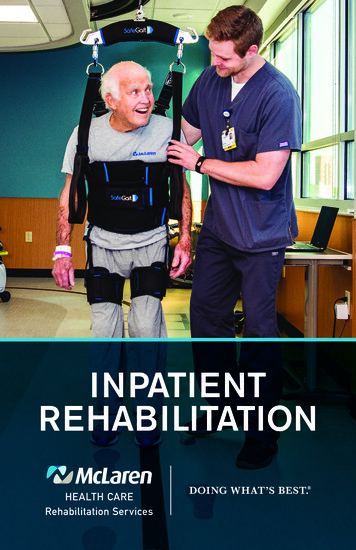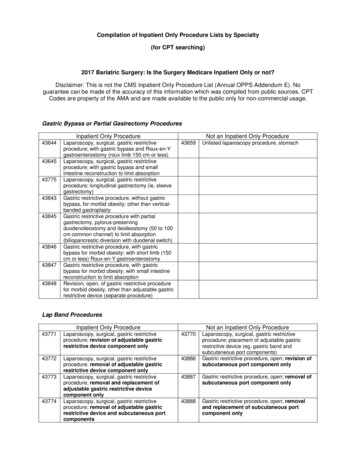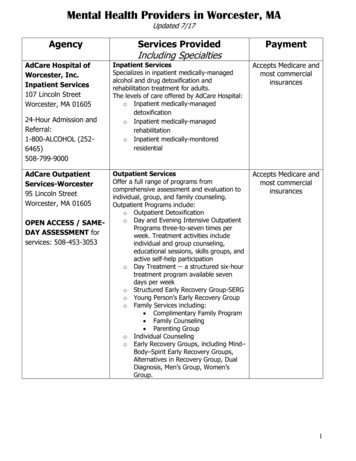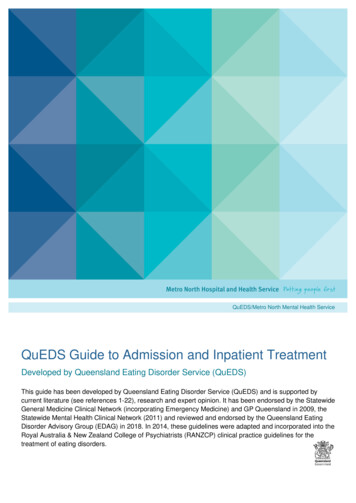
Transcription
QuEDS/Metro North Mental Health ServiceQuEDS Guide to Admission and Inpatient TreatmentDeveloped by Queensland Eating Disorder Service (QuEDS)This guide has been developed by Queensland Eating Disorder Service (QuEDS) and is supported bycurrent literature (see references 1-22), research and expert opinion. It has been endorsed by the StatewideGeneral Medicine Clinical Network (incorporating Emergency Medicine) and GP Queensland in 2009, theStatewide Mental Health Clinical Network (2011) and reviewed and endorsed by the Queensland EatingDisorder Advisory Group (EDAG) in 2018. In 2014, these guidelines were adapted and incorporated into theRoyal Australia & New Zealand College of Psychiatrists (RANZCP) clinical practice guidelines for thetreatment of eating disorders.
Published by the State of Queensland (Metro North Hospital and Health Service), July 2020This document is licensed under a Creative Commons Attribution 3.0 Australia licence.To view a copy of this licence, visit creativecommons.org/licenses/by/3.0/au State of Queensland (Metro North Hospital and Health Service) 2019.You are free to copy, communicate and adapt the work, as long as you attribute the State of Queensland(Metro North Hospital and Health Service).For more information, contact:QuEDS, Metro North Hospital and Health Service, 2 Finney Road, Indooroopilly Queensland, 4068.Email QuEDS@health.qld.gov.auPhone 07 3100 7500.An electronic version of this document is available at www.metronorth.health.qld.gov.auDisclaimer:The content presented in this publication is distributed by the Queensland Government as an information source only. The State of Queensland makes no statements,representations or warranties about the accuracy, completeness or reliability of any information contained in this publication. The State of Queensland disclaims allresponsibility and all liability (including without limitation for liability in negligence) for all expenses, losses, damages and costs you might incur as a result of theinformation being inaccurate or incomplete in any way, and for any reason reliance was placed on such information.QuEDS Guide to Admission and Inpatient TreatmentV4 Effective: July 2020 Review: July 2022I
ContentsContents . iiQueensland Health Eating Disorder Services . 1Background. 1Involving Family and Carers . 1Objectives . 1Goals of Inpatient Treatment . 1Table 1: QuEDS Indicators for Admission . 2Flowchart A: Overview of treatment for adults with eating disorders . 3Table 2: Guide for Emergency Department Clinicians: . 4ADMISSION TO MEDICAL WARD . 5Table 3: Medical Management . 5Management of Medical Complications . 6Nutritional Management . 6Nutrition Option 1: Best practice and strongly recommended . 6Nutrition Option 2: If nasogastric feeding is not possible or delayed . 7Nursing Management . 8Table 6: Nursing Observations in medical wards . 8Guidelines for transfer from medical ward to mental health unit . 9ADMISSION TO MENTAL HEALTH WARD . 9Medical Management . 9Nursing Management . 9Nutritional Management . 10The process for the 3 step meal plan is as follows: . 10Table 7: 6000kJ/1500kcal Default 3 step meal plan . 10Implementation of meal plan . 11Nutritional Complications . 11Discharge Nutrition . 11Leave Guidelines . 11Criteria and guidelines for transfer to RBWH adult specialist eating disorders beds . 12Discharge Planning . 12Appendix I: A Guide to Applying the Mental Health Act 2016 (MHA) and Guardianship andAdministration Act 2000 (GAA) for the Assessment and Treatment of Patients with an Eating Disorder 13Appendix II: Key medical considerations . 15Appendix III: Nutrition Flowchart . 16Appendix IV: Application of QuEDS guidelines for adults with ARFID . Error! Bookmark not defined.Appendix V: Supportive Meal Therapy . 21Appendix VI: Leave Guidelines .22QuEDS Guide to Admission and Inpatient TreatmentII
Appendix VII: QuEDS Weight Chart. 24Appendix VIII: Specialist Eating Disorder Services .25References . 25QuEDS Guide to Admission and Inpatient TreatmentIII
Queensland Health Eating Disorder ServicesThe Queensland Eating Disorder Service (QuEDS) aims to increase the capacity of local services to safelyand effectively treat people with eating disorders. QuEDS is available to provide support to treatingteams/clinicians throughout Queensland. Local Specialist Eating Disorder Services have been establishedwithin the Gold Coast HHS, Sunshine Coast HHS and Cairns HHS. QuEDS may be able to facilitate accessto specialist beds at the RBWH if a trial of local treatment with QuEDS input has not been able to achievetreatment goals. Additional QuEDS resources and guidelines can also be accessed hcare-services/eating-disorderBackgroundEating disorders are associated with significant psychiatric and medical morbidity. Common eating disorderdiagnoses requiring hospital admission/treatment include: Anorexia Nervosa (AN), Avoidant RestrictiveFeeding Intake Disorder (ARFID*), Bulimia Nervosa (BN), Binge Eating Disorder (BED), Other SpecifiedFeeding or Eating Disorder (OSFED), Unspecified Feeding or Eating Disorder (UFED) and other atypicaleating disorders. Further information on diagnoses is covered in the -5%20criteria.pdf). Effective management requires closecollaboration between clinicians working in psychiatric, medical and community settings. The overarchingprinciple that guides the management of patients with eating disorders within Queensland Health (QH) isthat patients have the right to access medical and mental health services across the continuum of careincluding community, inpatient and specialist services (NEDC National Practice Standards) as determinedby their medical and mental health needs.*Further information on the application of these guidelines for ARFID diagnoses is provided in Appendix IVInvolving Family and CarersUnless there are contra-indications, or the individual is opposed, family or significant others should be enlistedas partners in the assessment and treatment process. Given the considerable burden on family, it is importantthat the family is provided with appropriate support and information (see QuEDS Family Support Guide,QuEDS Patient Support Guide on QuEDS website). Further resources are available at Eating DisordersQueensland - sorder-services-qld/queensland-carers/(Clinical Practice Guidelines for the Treatment of Eating Disorders. Royal Australian and New Zealand College ofPsychiatrists; 2014.)ObjectivesThe following guidelines will assist treating teams to: Manage the medical and psychological risks and needs of people with eating disorders, Promote coordinated care with a smooth transition across medical, mental health and specialistservices, Encourage state-wide consistency in treatment and management, Include families and carers in the service response to people affected by eating disorders.Goals of Inpatient TreatmentThe goals of inpatient treatment are (in the following order): medical stabilisation; prevention and treatment of re-feeding syndrome; engagement of carers, family and community supports; nutritional resuscitation and rehabilitation with weight restoration as appropriate; reversal of cognitive effects of starvation so the person can benefit from psychotherapy; to ensure the patient is able to consume adequate nutrition and contain compensatory behavioursboth on and off the ward prior to discharge; and arrangement of appropriate outpatient follow-up care.QuEDS Guide to Admission and Inpatient TreatmentVersion 4 Effective: July 2020; Review July 2022.1
Table 1: QuEDS Indicators for Admission to Adult Inpatient Beds ( 18yrs)If ONE or MORE of these parameters is met at the time of assessment, inpatient treatment is advised (2). The list inthe table is not exhaustive; therefore, any other medical problems which are of concern should be discussed with therelevant medical team. Contact QuEDS Intake or your local Qld Health Specialist Eating Disorder Service for supportduring business hours on (07) 3114 0809.Medical admission indicatedβMedical ParametersPhysicalobservationsSystolic blood pressurePostural bloodpressure#PathologyNutritionalrate#Postural tachycardia 50 bpm20bpm 35.5C12-lead ECGAny arrhythmia including:QTc prolongation, or non-specific STor T-wave changes includinginversion or biphasic wavesBlood sugarBelow normal range ( 3.0 mmol/L)Sodium 125 mmol/LPotassiumBelow normal range ( 3.5 mmol/L)MagnesiumBelow normal range ( 0.7mmol/L)PhosphateBelow normal range ( 0.75mmol/L)eGFR 60ml/min/1.73m2 or rapidly dropping(25% drop within a week)Albumin 30 g/LLiver enzymesMarkedly elevated (AST or ALT 500)Neutrophils 0.7 x 109/LRe-feeding riskHigh – see Appendix II 36.0C 130 mmol/L*Below normal range ( 35g/L) 1.0 x 109/LGrossly inadequate nutritional/fluid intake ( 1000kCal/4MJ daily)Unmanageable compensatory behavior (vomiting, exercise, laxatives)Weight lossBody Mass IndexOther 20mmHg drop with standingTempOral intakeAnthropometry 90 mmHg 40 bpm or 120 bpmHeart ratePostural Heart 80mmHgPsychiatric admissionindicated µRapid weight loss (i.e. 1 kg/week over several weeks)(BMI)@BMI 12 kg/m2Community supportsBMI 12-14 kg/m2Not responding to outpatienttreatment* Please note, any biochemical/electrolyte abnormality which has not responded to adequatereplacement within the first 24 hours of admission should be reviewed by a Medical RegistrarurgentlyβMedical admission is recommended if BMI 12 or there are significant abnormalities of physical parametersas indicated in the table above.µPsychiatric admission is indicated if BMI 12-14, or there are other abnormalities of physical parameters thatare not of sufficient severity to warrant medical admission.#Postural HR and BP are measured from lying to standing with a 2minute break. Postural tachycardia is only a criterion for admission if the patient has restricted oral intake or weight loss.@Body Mass Index (BMI) is Weight (kg)/ Height (m2) – see QuEDS Weight Chart – Appendix VIINB: For Adolescent admission parameters please refer to “Assessment and treatment of children and adolescentswith eating disorders in Qld” see https://www.health.qld.gov.au/ data/assets/pdf file/0040/956569/qh-gdl-961.pdfOr 2page summary of Adolescent Admission Parameters on QuEDS internet ealthcare-services/eating-disorderFor support re: adolescent eating disorder treatment (business hours) contact CYMHS-EDP Intake on (07) 3397 9077.QuEDS Guide to Admission and Inpatient TreatmentVersion 4 Effective: July 2020; Review July 2022.2
Flowchart A: Overview of Treatment for Adults with Eating Disorders ( 18yrs)Also refer to Table 2: Guide for Emergency Department Clinicians, Page 4.YesSend to local emergency dept(DEM) for medical/psychiatricassessment. See also QuEDSGuide for EmergencyDepartment Clinicians, page 4Does the patient meet any of themedical parameters foradmission to a medical ward?See page 2, Table 1.YesAdmit to medical ward with localmental health ConsultationLiaison Service /- Qld HealthSpecialist Eating DisorderService input until all thefollowing achieved: Refeeding risk passed(7days from thecommencement of refeeding) Medically stable (i.e. NOTmeeting criteria for medicaladmission) for 48hrs BMI 14*Consider criteria for eligibilityfor transfer as below ** Transfer criteria as follows: Systolic BP 90 HR 50 and 100 No significant posturaltachycardia or hypotension Normal ECG Normal electrolytes At goal nutrition for at least48hrsMedical to mental health wardtransfer can occur at BMI 12-14 ifthere is agreement between themedical and mental health units,and patient is medically stable for24 hrs as above.For support with Adolescent ( 18yrs)admissions contact CYMHS-EatingDisorder Programme Intake duringbusiness hours (07) 33979077. Plus,refer to Adolescent ( 18yrs) EatingDisorder Admission Pathways(summary by CYMHS-EDP) on QuEDSwebsite.The patient meets ANY of thecriteria for a medical/psychiatricadmission as outlined in theQuEDS Indicators forAdmission to Adult InpatientBeds See page 2, Table 1.NoNoArrange psychiatricreview/assessment. Is amental health admissionrequired to address failure ofoutpatient treatment or meetother mental health needs?NoAdmit / transfer to local mentalhealth inpatient unit. Considerconsultation input from QldHealth Specialist Eating DisorderService until: BMI 17–20 (adults only) Linked in with appropriatefollow-up post discharge(medical monitoring evidence-basedpsychological treatment /- dietetic intervention)Transfer*Local community-basedtreatment /- advice from aSpecialist Eating DisorderClinician/Service.Weekly medical review as perQuEDS Indicators forAdmission outlined in Table1 (page 2), plus, if agreeable,evidence-basedpsychological treatment e.g.CBTe, SSCM, MANTRA., /dietetic intervention.Consider referral to a QldHealth Specialist EatingDisorder Service forassessment and treatmentrecommendations.ConsiderHas the patient achieved theinpatient treatment goals in thelocal mental health inpatient unitwith input from a Qld HealthSpecialist Eating DisorderService?YesDischarge to local communitymental health and/or primary careservices for: Weekly medical monitoring asper QuEDS Indicators forAdmission, plus Evidence-basedpsychological treatment e.g.CBTe, /- dieteticintervention. Consider accessingtreatment/support fromprivate/non-governmentorganisations. See AppendixVIII.NoYesConsider transfer to aspecialist eating disordersbed at RBWH untiltreatment goals achievedQld Health Specialist Eating Disorder Services are available to providesupport and advice to treating teams/clinicians in the inpatient, outpatientand community setting. Services include: QuEDS, EDS-SC, GCHHS-AEDP,N-QuEDS. See Appendix VIII for full listing.Queensland Eating Disorder Service (QuEDS)For health services outside Gold Coast, Sunshine Coast and NorthQueensland.Please contact us via QuEDSConsultationServices@health.qld.gov.auOr via our intake line on (07) 3114 0809.Resources, referral forms etc are available on our ealthcare-services/eating-disorderor google QuEDS.QuEDS Guide to Admission and Inpatient TreatmentVersion 4 Effective: July 2020; Review July 2022.3
Table 2: Guide for Emergency Department Clinicians:QuEDS/Eating Disorder Admission Pathways for Adults ( 18yrs)Refer to Table 1: QuEDS Indicators for Admission to Adult Inpatient Beds ( 18yrs) in this document, oravailable on QuEDS internet website. re-services/eating-disorderFor more information please refer to the QuEDS admission guidelines on QHEPS or google wh/healthcare-services/eating-disorderInitial Assessment: Weight (document potential confounders: hydration status, clothing, heavy jewellery etc.) Height measured in Emergency Department (do NOT accept patient report) Postural physical observations (HR and BP); ensure 2 minutes apart – lying to standing ECG and blood tests from day of presentation: FBC, eLFTs, Phosphate, Mg, glucose, eGFR, TFTs, B12, Folate Rate of recent weight loss or severe restriction of nutritional intake (inc. food and fluid) Ask about vomiting, laxative use and exerciseNB. Please take physical observations recorded by the GP into considerationAdminister IM/IV thiamine, PRIOR to Prompt nutrition provision – liquid supplements (eg Resource Plus/Ensure Plus/Fortisip Compact), or food whilstawaiting implementation of nutrition prescription.NB. Delayed provision of adequate nutrition in a malnourished client may exacerbate medical instabilityA. Patient meets ANY of the physical parameters indicating need for medical admission – as per Table 1 Provide the following:o Thiamine 300mg IM/IV 30 minutes prior to feeding and daily for initial three dayso Electrolytes (K , Mg2 , PO4-) supplement as required https://www.health.qld.gov.au/ data/assets/pdf file/0023/700088/electrolyte-glines-adult.pdfo Multivitamin 1 oral tablet daily Insert nasogastric tube (NGT) and confirm placement as per local procedure If patient refuses treatment, assess capacity and consider Guardianship & Administration Act 2000 (GAA) orMental Health Act 2016 (MHA). Any medical doctor can place a patient on a Recommendation for Assessment(https://www.health.qld.gov.au/ data/assets/pdf file/0019/574012/f recommend assess.pdf ) while awaiting psychiatric review.Consult your local psychiatric team as required. Medical officer to complete order for nasogastric (NG) feeds as belowo Commence 40ml/hr Nutrison Energy (or equivalent) 24/24 (1.5kcal/ml – fibre-free) with 80ml water flushes4hourly (provides 1300ml and 6000kJ/1500kcal). Deemed gluten free.o If diagnosed with anaphylactic reaction to fish or dairy commence 60ml/hr Nutrison Advanced Diason (orequivalent allergen free formula) 24/24 (1.0kcal/ml – fibre-free) with 60ml water flushes 4hrly (provides 1600ml fluid and 6000kJ/1500kcal) Refer to dietitian Recommend bed rest and supervised use of bathroom Whilst on enteral/nasogastric feeds limit oral intake to 250ml water (1cup) per day or maintain NBM B. PatientJudicioususeANYof extraIV/NGfluidsparametersgiven risk ofpulmonaryoedemawith ongoingclinical– monitoringmeetsof thephysicalindicatingneedfor psychiatricadmissionas per Tableof1fluidstatus by medical officer. Arrange URGENT psychiatric assessment with recommendation for admission to mental health unit on oral meal planC. Patient does NOT meet any of the parameters indicating need for admission – as per Table 1 Arrange psychiatric review/assessment to determine if mental health admission is required to address failure ofoutpatient treatment or meet other mental health needsD. Prior to discharge from Emergency Department Arrange follow up with local community services including letter to GP requiring weekly monitoring as per QuEDSIndicators for Admission to Adult Inpatient Beds Consider contact with local Qld Health Specialist Eating Disorder Service or QuEDS Intake (07) 3114 0809 re:appropriate community follow-up (business hours only)Actions for GP to consider include: Adults: Referral to a Specialist Eating Disorder Service for assessment, diagnostic clarification or treatment advice. Adolescents: Referral to local CYMHSQld Health Specialist Eating Disorder Services include: QuEDS, EDS-SC, GCHHS-EDP, N-QuEDS (Appendix VIII).For support with Adolescent ( 18yrs) admissions contact CYMHS-Eating Disorder Programme Intake duringbusiness hours (07) 33979077. Plus, refer to Adolescent ( 18yrs) Eating Disorder Admission Pathways(summary by CYMHS-EDP) on QuEDS website.To obtain NG feeds contact . The Eating Disorder Dietitian is .On the weekend call .QuEDS Guide to Admission and Inpatient TreatmentVersion 4 Effective: July 2020; Review July 2022.4
ADMISSION TO MEDICAL WARDTO MINIMISE THE RISK OF RE-FEEDING SYNDROME IT IS RECOMMENDED YOUR TEAMCOMMENCE THESE ACTIONS IMMEDIATELYTable 3: Medical ManagementConsultation Liaison (C/L) Psychiatry teams are available to provide adequate, regular and frequent (daily ifrequired) support to the medical team to assist them with their patients’ behavioural and psychologicalmanagement.Medical monitoring is a cornerstone of treatment in both the inpatient (medical/mental health ward) andcommunity setting. The table below outlines appropriate medical monitoring from initial presentation tohospital and a guide to reducing frequency as clinically indicated throughout the admission.OrdersMedicationsFrequency atcommencementReduction as clinicallyindicated and after initialrefeeding periodThiamine300mg daily IM/IV first 3days100mg oral daily after first 3daysMultivitaminDailyDailyTFTsB12/folateInitialAs clinically indicatedFBC, e/LFTs, Phosphate,Mg, eGFRDaily for at least the first7-10 daysSecond dailyBy week 3, Twice weekly onweigh daysECGsDailySecond daily or twice weeklyBGLs (capillary)If on NGF: QID 0200hrsIf on oral meal plan:0200hrs, 0600hrs plus 12hrs post main mealsBDPostural BP HRQIDBDTemperatureQIDBDFluid balance chartIncluding IV, NG, oralfood/fluid. Include outputif medically indicatedRequired for duration ofadmission.WeightTwice weeklyTwice weeklyBowel chartDailyDailyOther/Nutritional Nasogastric Tube (NGT)Fine boreInsert in emergencydepartmentRemove NGT if nutrition goalsare consistently met via oralroute only (meal plan/liquidsupplements) for 7daysEnteral feed:1.5kcal/mlfibre-free enteral formula(Nutrison Energy orequivalent)Initial rate of 40ml/hrcontinuous 24/24Increase rate as per Table 4:Enteral Nutrition Regimen,page 6.Food chart (if only oralintake)Observed anddocumented at eachmeal/snackPathologyObservationsCan cease if BGLs continue tobe within normal rangeRequest urgent DietitianreviewObserved and documented ateach meal/snackQuEDS Guide to Admission and Inpatient TreatmentVersion 4 Effective: July 2020; Review July 2022.5
Management of Medical Complications Immediately replace potassium (K ), phosphate (PO4-3), magnesium (Mg) if these are found to bedeficient using Qld health guidelines - “Prescribing Guidelines for HYPO-Electrolyte Disturbances inAdults” https://www.health.qld.gov.au/ data/assets/pdf file/0023/700088/electrolyte-glines-adult.pdf Hypoglycaemic episodes often occur in the re-feeding stage of severely malnourished patients. LowBGLs ( 4.0mmol/l) should be managed according to the document ‘Insulin Subcutaneous Order andBlood Glucose Record Adult that include Guidelines for Medical Officer responding to Blood GlucoseAlerts and Hypoglycaemia Management in Diabetes: BGL less than 4 /docs/sw006-adult-insulin-subcut-blg.pdfNote: Wherever the above document recommends giving a fast-acting carbohydrate, a slow-actingcarbohydrate should be given in addition (e.g. Resource Plus/Ensure Plus/Fortisip, 250ml glass of milkplus 2 portion packs of crackers/1 portion pack sweet biscuits). Manage constipation as clinically indicated with stool softeners (eg Movicol). Stimulant laxatives(including Senna) should be avoided. Seek specialist assessment as required. See also Appendix II – Key Medical ConsiderationsNutritional ManagementThe following recommendations are aimed at optimising medical stability, whilst reducing medical risk, timeto goal energy and length of admission. Ensure your ward dietitian has been notified.DELAY INITIATING ENTERAL FEEDING IN A MALNOURISHED CLIENT MAY DELAYPROGRESSION TO MEDICAL STABILITY AND INCREASE DURATION OF STAYFor further details please refer to ‘QuEDS Recommendations for Nutritional Management of patientswith an eating disorder on medical wards’ via wchart.pdfNutrition Option 1: Best practice and strongly recommended Commence 24hr continuous nasogastric feeding at 6000kJ/1500kcal per day using a 1.5kcal/mL(6kJ/mL) fibre-free complete enteral feed (eg Nutrison Energy). Consider use of Nutrison Advanced Diason (or equivalent allergen free formula) if diagnosed withanaphylactic reaction to fish or dairy. Also, see standardised eating disorder enteral feeding regimes by COD-ED on NEMO (NutritionEducation Materials Online) - # If nasogastric feeds are interrupted, consider provision of an equivalent catch-up bolus. If volume ofloss is unknown, then provide catch up bolus of 150ml.Table 4: Enteral Feeding RegimenDayRegimen – 24hr continuous enteral feedsEnergy (kJ/kcal)Day 1, 240ml/hr Nutrison Energy (or equivalent)6000/1500Day 3, 455ml/hr Nutrison Energy (or equivalent)8000/2000Day 5, 670ml/hr Nutrison Energy (or equivalent)10000/2500Day 7 onwards80ml/hr Nutrison Energy (or equivalent)12000/3000QuEDS Guide to Admission and Inpatient TreatmentVersion 4 Effective: July 2020; Review July 2022.6
Nutrition Option 2: If nasogastric feeding is not possible or delayed Commence oral liquid diet at 6000kJ/1500kcal per day (see default meal plan below)Table 5: Oral Liquid Nutrition Plan – interim use onlyMealSupplement PrescribedBreakfast 0730hrs1 bottle/tetrapak Resource plus/Ensure plus/Fortisip Compact(or equivalent)Morning tea 1000hrs½ bottle/tetrapak Resource plus/Ensure plus/Fortisip Compact(or equivalent)Lunch 1230hrs1 bottle/tetrapak Resource plus/Ensure plus/Fortisip Compact(or equivalent)Afternoon tea 1530hrs½ bottle/tetrapak Resource plus/Ensure plus/Fortisip Compact(or equivalent)Dinner 1730hrs1 bottle/tetrapak Resource plus/Ensure plus/Fortisip Compact(or equivalent)Supper 1930hrs½ bottle/tetrapak Resource plus/Ensure plus/Fortisip Compact(or equivalent)Late Supper 2130hrs½ bottle/tetrapak Resource plus/Ensure plus/Fortisip Compact(or equivalent)Other Considerations Use low fibre, energy dense feeds/supplements (1.5kcal/ml or 6kJ/ml) Progress prescribed nutrition in 2000kJ/500kcal increments every second day until goal energy of12000kJ/3000kcal is reached (some patients have higher goal requirements – use clinical judgement) Calculate fluid requirements based on 40ml/kg (unless medical management indicates otherwise) Limit oral water intake to 250ml/day whilst on nasogastric feeding. No other oral liquid or food, apartfrom that required for medication or hydration purposes, is to be taken. No food should be brought in from outside/home Avoid diet foods, lollies or chewing gum When discussing weight with patient, use Body Mass Index Banding (see QuEDS weight chart –Appendix VII) or intranet link belowhttp://hi.bns.health.qld.gov.au/forms/patient record/forms/mr 60088.pdfIf medically stable and goal energy has been provi
Queensland Health Eating Disorder Services The Queensland Eating Disorder Service (QuEDS) aims to increase the capacity of local services to safely and effectively treat people with eating disorders. QuEDS is available to provide support to treating teams/clinicians throughout Queensland. Local Specialist Eating Disorder Services have been .
